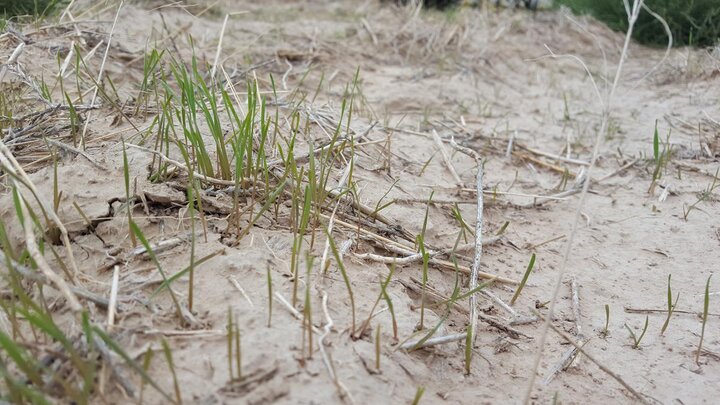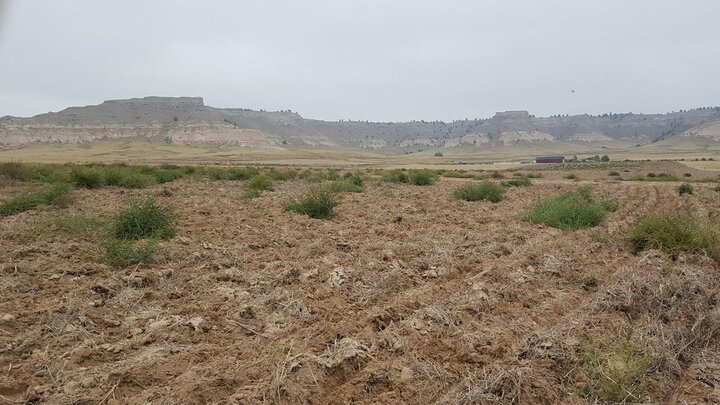

Fall is the best time to manage winter annual weeds in winter wheat. Weeds such as downy brome, feral rye, marestail, mustards, and the perennial dandelion are more easily managed soon after emergence than in the following spring. Although costs to control weeds may seem prohibitive to dryland producers, it’s important to consider the long-term implications of timely weed control in crop production systems.
Wheat should be seeded in a weed-free field. Weeds that were left unmanaged prior to wheat planting use valuable nutrients and soil water needed for the next crop. Unmanaged weeds also produce seeds to replenish the soil seed bank. Furthermore, weeds that include volunteer wheat are hosts to insect pests that vector diseases. To eliminate the threat of diseases such as Wheat Streak Mosaic Virus, grassy weeds (including volunteer wheat) should be controlled at least two weeks before seeding winter wheat.
Good weed control in the winter wheat will increase the success of controlling weeds after winter wheat harvest. A study conducted in Tribune, Kan., by Kansas State researcher Alan Schlegel demonstrated the impact of wheat stubble management and weed control timings on corn yield. Results in Table 1 show decreasing corn yield following wheat when the initial weed control is delayed or not applied at all.
| Weed control timing | Stubble Height 7.5 inches* Corn BU/AC | Stubble Height 15 inches* Corn Bu/ac |
|---|---|---|
| Initial spray in July | 44 | 59 |
| Initial spray in mid-August | 25 | 38 |
| No post-harvest weed control | 13 | 40 |
| *60 bu/ac wheat prior to corn crop | ||
Start by Evaluating the Effectiveness of Weed Control in the Previous Year
Producers can start by reviewing the previous year’s weed control program, determining what worked well, what went wrong, and identifying any areas of particular fields that might need special attention to control problem weeds.
Poor weed control could be related to a thin crop stand, seeding date, seeding depth, crop rotation, weed size, dust, environmental conditions at time of spraying, plugged nozzles, improper application of herbicides and tank-mix partners, or herbicide-resistant weeds, among other things.
Weed management for this season’s winter wheat production should have been started two years ago after the last wheat crop was harvested, during the after-harvest fallow period, corn growing season, and summer fallow. If growers were proactively managing weeds during this time, weed management for the 2018-19 winter wheat growing season should not be as challenging.
The vast majority of seeds from the most troublesome weed species in winter wheat typically don’t last more than two years in the soil seedbank, and as long as these species were not allowed to reproduce in the corn crop and fallow periods, the weed pressure within a field should not be very high.
Starting Clean
Similar to other crops, it is recommended to seed winter wheat into a weed-free seed bed. Once wheat has been planted and emerged, the available options for weed control are dramatically reduced.
Two major groups of weeds compete with winter wheat: winter annuals that emerge in the fall and summer annuals, which start emerging in the spring.
Winter annual weeds are the most challenging to control because they start to grow at the same time as the crop, if not earlier. Management of summer annual weeds is not as difficult because by the time these species are emerging, the winter wheat crop should be closing canopy, if stands are good, and naturally suppressing these weeds.
Remember to read and follow herbicide labels to avoid any potential injury from herbicide carryover. Table 2 lists some herbicides and their rotation restrictions.
Getting a Jump Now on Winter Annual Weeds
Herbicides applied to winter annual weeds in the late fall usually perform much better than those applied in the spring. Weeds are smaller and also in the seedling stage versus tillering stage. Winter annual weeds can begin emerging as early as August and continue to emerge through early March. By emerging so early in the cropping year, winter annuals can become tolerant to herbicides by the time spring applications are made. With any winter annual weed, growers should consider an effective burndown program to start “clean.”
Limited post-emergence options are available for marestail control in the fall, as most synthetic auxin herbicides cannot be applied before tillering. However, dicamba is labeled in winter wheat for application from planting up until nodes are visible in the spring. Dicamba will provide control of both ALS- and glyphosate-resistant marestail.
For control of downy brome in the fall, Maverick, Olympus, and Powerflex all provide some level of suppression. Beyond is usually a more effective option if Clearfield wheat was seeded. A second herbicide tolerant wheat, CoAxium, has entered the market. This wheat will be sprayed with Aggressor herbicide and has performed well in trials. The effectiveness off all herbicides labeled for downy brome control in winter wheat can be quite variable from year to year, with performance of fall applied herbicides ranging from moderate to excellent. While downy brome control with any herbicide can be quite variable from year to year, multiple studies from UNL and other universities have demonstrated consistently greater levels of control from fall application compared with spring applications. Spring application of such herbicides can be highly influenced by weather conditions, weeds stage of development and growth rate.
| Herbicide | Rotation Restriction to Winter Wheat |
|---|---|
| 2,4-D Ester | 30 Days |
| 2,4-D Amine | 30 Days |
| Dicamba | None |
| Glyphosate | None |
| MCPA | 0-3 months depending on rate |
| Starane | 3 months |
| Stinger | none |
| Widematch | none |
